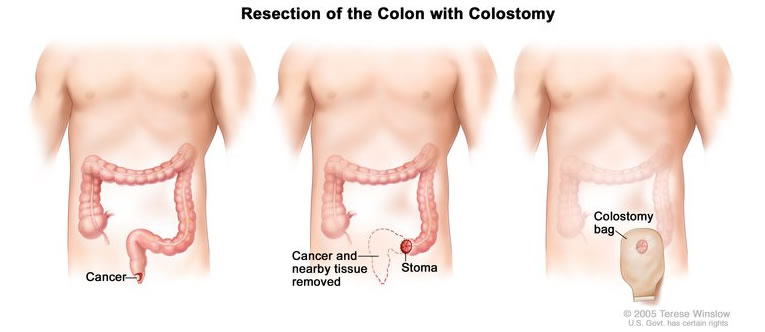- Abscess Incision and Drainage
- Advancement Flap Repair
- Anal Bulking
- Anal Tattooing
- Botulinum Toxin Injection
- Colectomy
- Delorme’s Procedure
- ELAPE Procedure
- Femoral Hernia Repair
- Fistulotomy
- Haemorrhoidectomy
- HALO-RAR Procedure
- Inguinal Hernia Repair
- Intersphincteric APR
- Lateral Internal Sphincterotomy
- Low Anterior Resection
- Pelvic Organ Prolapse
- Perineal Rectosigmoidectomy
- Rectoanal Repair
- Rubber Band Ligation
- Stapled Haemorrhoidopexy
- Stoma Creation
- Stoma Reversal
- Transanal Rectocoele Repair
- Umbilical Hernia Repair
ELAPE Procedure
An ELAPE (extra-levator abdominal perineal resection) is performed to treat cancer of the rectum when the cancer is very near or affects the anal sphincter muscles. You may have radiotherapy or chemoradiation (chemotherapy and radiotherapy) to shrink the cancer beforehand to make it easier to remove and decrease the chance of it coming back later on.
The procedure involves removing the anus, rectum and associated pelvic floor muscles, along with part of the sigmoid colon. The anus is then closed permanently, so a colostomy (where your large bowel opens onto your skin) is needed lifelong. An ELAPE is designed to give patients the best chance of being free of their rectal cancer. You will have the opportunity to discuss fully all the risks and benefits of the operation with me before signing your consent form.

An ELAPE has two parts to it, ie, an abdominal part, which is almost always planned as a minimally invasive (laparoscopic or robotic) approach and a perineal part, which is performed using an open approach.
The abdominal part of the procedure is performed using instruments inserted through several small cuts on the lower abdomen.These cuts are about 1–1.5 cm long. A small video camera is passed through one of the cuts so that the inside of the abdomen can be seen on a TV monitor, and special surgical tools are passed through the other cuts to free the structures to be removed from the surrounding tissues. Carbon dioxide gas is used to inflate the abdomen slowly and give a clearer view of the rectum and colon. Three-quarters of the operation is performed by the keyhole technique, but is stopped once the pelvic floor is reached. The portion of the bowel containing the cancer is disconnected from the healthy colon using a keyhole stapling device. The healthy end of the bowel is brought to the outside of the body through a larger cut (3 cm long) on the left side of the lower abdomen and sutured to the skin, forming a colostomy. Faeces will pass through this into a stoma bag. I may decide to put a mesh in the abdomen around this colostomy to reduce the risk of complications in the future. The other surgical wounds are closed with dissolvable stitches, followed by application of a surgical glue that makes the wounds watertight.
The perineal part of the procedure has two stages, both done in the same sitting. In the first stage, the skin around the anus, rectum, and pelvic floor muscles are divided and the operation continued upwards to join up to the point where the abdominal operation ceased. This involves making a cut (10–15 cm long) in the perineum (the area between the anus and scrotum in men or vagina in women) and removal of the coccyx. In the second stage, a plastic surgeon comes in to fill the gap where the anus and pelvic floor used to be with a flap of healthy tissue, usually taken from the buttocks. The graft is rich in blood vessels and aids healing by improving the blood supply to the wound site. In women, the vagina can be recreated at this time if needed.
The blood vessels supplying the structures that have been removed are sealed and cut by special surgical instruments via the abdomen and perineum so the amount of blood loss is minimal. A surgical drain is placed in the abdomen near the colostomy site. This is a thin tube that comes through the abdominal wall to the outside.
You will be given a long-acting antibiotic in the anaesthetic room and an injection of local anaesthetic before you leave the operating theatre. The whole procedure takes 3–5 hours to perform, depending on complexity and patient factors.
There is a 5% chance of a planned ELAPE that starts as a laparoscopic procedure needing to be switched to an open one. This involves making a single long (20 cm) incision on the lower abdomen to access the rectum and using surgical tools directly to free the rectum from the surrounding tissue. Again, the procedure takes 3–4 hours, depending on complexity and patient factors. This is most likely to occur in patients who are obese and in those who are found to have an obstruction or have adhesions from previous surgery.
An ELAPE procedure is done under general anaesthesia, so you will be asleep and feel no pain. You will need to fast from midnight on the night before if your surgery is scheduled for the morning, or from 7 am if it scheduled for the afternoon. You will be given an enema an hour or so before your surgery.
After your operation
After your surgery, you will be taken to the recovery area and then to the ward. When you wake up, you will have several tubes attached to your body, including an intravenous infusion tube in your arm to give you fluids and any necessary drugs, a catheter in your bladder to drain urine, and a drainage tube in your abdomen to remove any oozing fluid. Most or all of these tubes are removed after 24–48 hours. Supplementary oxygen is given by nasal prongs.
Some discomfort is common after this type of surgery when your local anaesthetic wears off. The anaesthetist will decide on the method of postoperative pain relief that is best for you. Oral painkillers are all that is needed in most patients, but others require intravenous analgesia or an epidural. Intravenous analgesia can be provided by a patient-controlled analgesia device, where a drip in your arm is connected to a syringe of pain-killing medication within a box. When the patient presses a button, a small dose of medication is pushed into the drip. There is a lockout that make it impossible to overdose. When you are discharged, you will be given pain medication to take home. It is best to keep taking this medication until discomfort when going to the toilet is manageable.
You can eat and drink as you wish after the operation, and if there is no problem with drinking, the drip providing fluid will be stopped. Some patients feel a little nauseous after eating and drinking soon after their surgery. In these patients, we wait a little longer before introducing food and fluids and keep the fluid drip going. You will be mobilised on the day following your surgery. The stay in hospital after an ELAPE procedure is around 7–10 days, and sometimes a little longer. Essentially, you will be able to go home when you are confident you can manage your stoma by yourself.
Many people find that their bowel function returns to normal within about 3 days after surgery, and they can resume their normal diet at that time. Eating a balanced diet after your operation will aid your recovery. You may be given take-home medication to thicken or loosen your stools as needed.
You will not be able to drive when you are discharged from hospital, so it is important to arrange a friend or relative to take you home. When patients can resume driving after this type of surgery is determined on a case-by-case basis. This is usually 2 weeks, but will be discussed with you after your operation. Most people need longer before they can safely, forcefully, and quickly press the emergency footbrake to avoid a potential incident whilst driving. Please let your insurance company know when you have been given the all-clear to resume driving.
When you get home
Many people feel tired and weak after major surgery of this type, and full recovery may take up to 2 months. When you get home, you will need someone to help with meals, housework, and shopping. For the first week or two you may tire easily, so try to alternate short periods of light activity and rest in bed, taking care not to spend too much time lying down because of the risk of developing a blood clot in your legs (deep venous thrombosis).
Do not lift anything heavy, such as children, groceries or washing, or do strenuous work like digging the garden or lawn mowing for the first 6 weeks. You may resume intercourse when you wish.
You may get some pain off and on around your wound for several months, especially as you start to move and exercise more. This is to be expected. Taking a mild painkiller regularly will help with this. If the pain does not seem to improve or you are worried, contact your GP or our colorectal nurses.
How soon you can return to work following this type of surgery depends on what type of work you do, and this will be discussed with you after your operation.
The laboratory report is usually available within 2 weeks of the surgery and will be discussed with you, along with any further treatment needed, at your next appointment with me, which will be 2 weeks after your procedure. You will also need a follow-up appointment with the plastic surgeon who repaired your perineal wound. This appointment will also be 2 weeks after your procedure, and it is important to avoid sitting down until you have been cleared to do so by the plastic surgeon. If you have any questions or concerns about your surgery, please contact my office.

